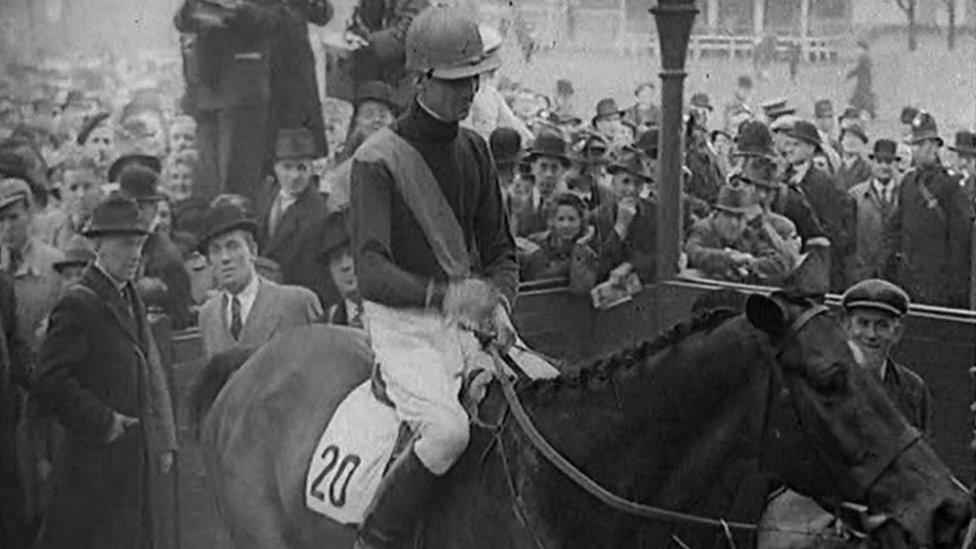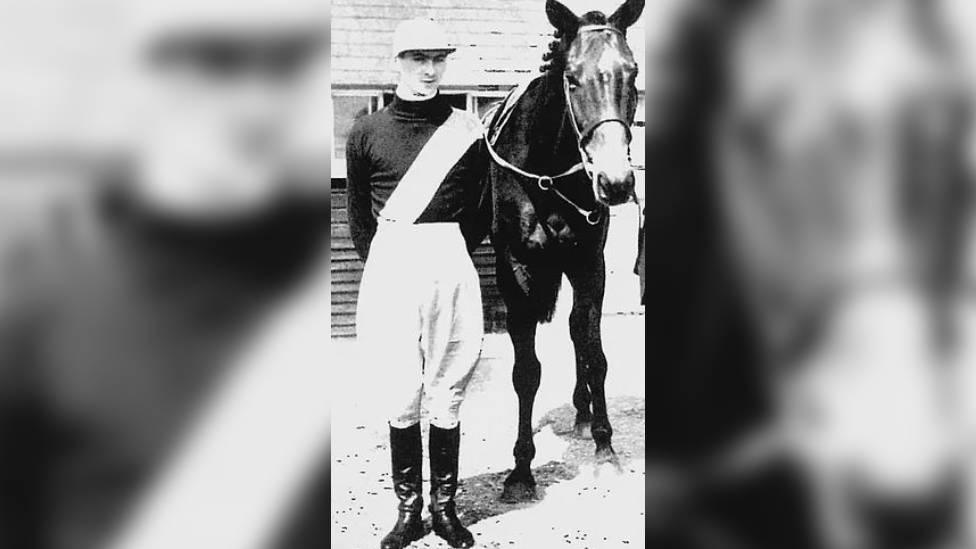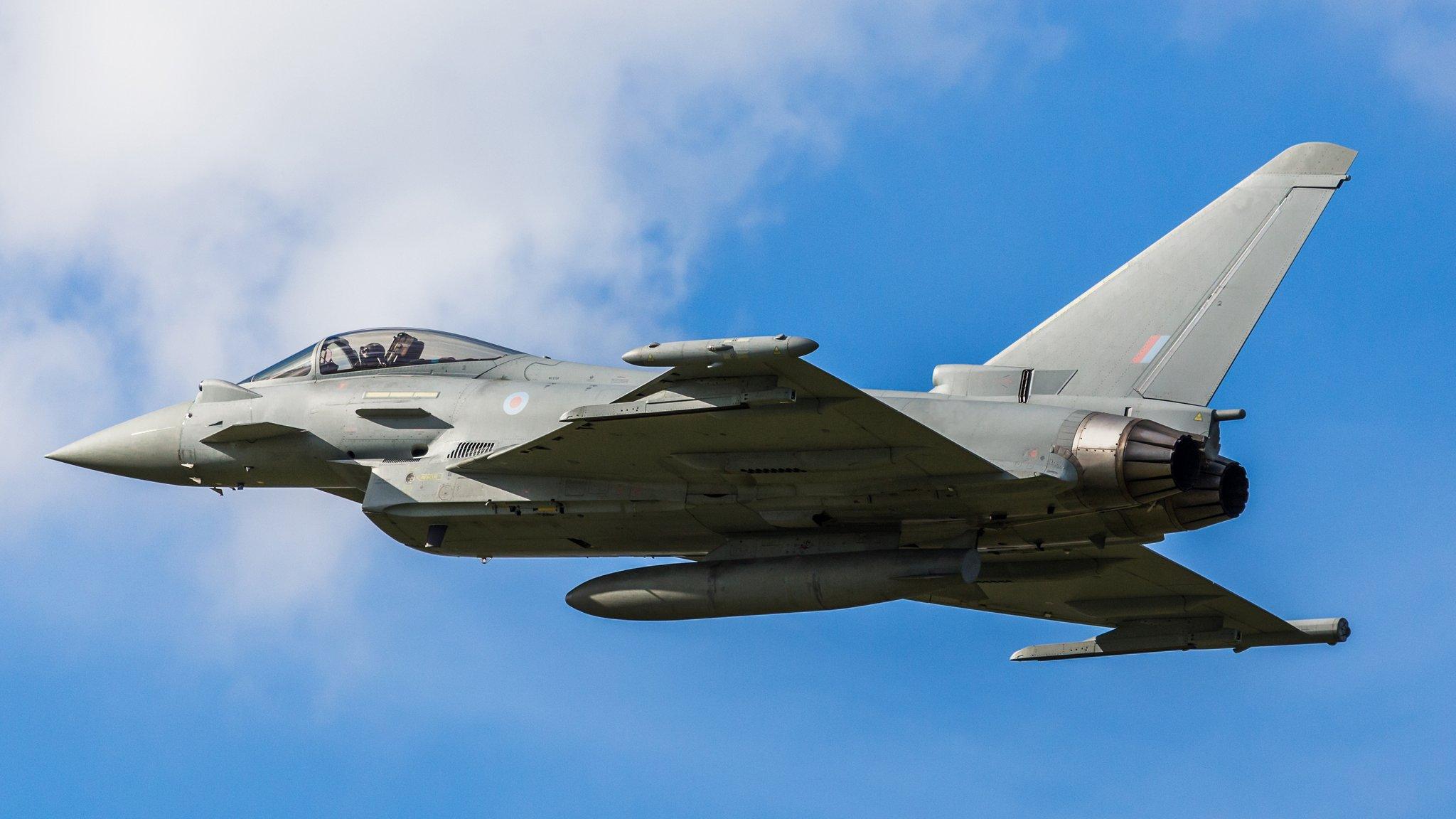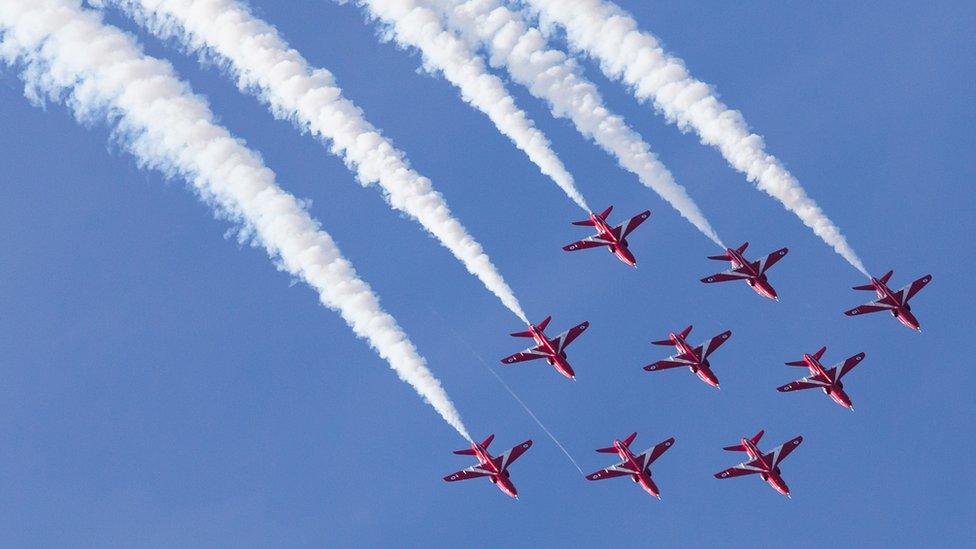Remembrance Sunday: The WW2 pilot who won the Grand National
- Published

Sgt Mervyn Anthony Jones rode Bogskar in the Grand National trials, which went on to win the final of the world famous horse race
It was arguably the most dangerous job it was possible to have in the RAF during World War Two.
Flying unarmed and unarmoured, pilots of the Photographic Reconnaissance Unit (PRU) weren't expected to live longer than two-and-a-half months.
Yet one Llanelli-born PRU pilot decided his life didn't have quite enough adrenaline in it, so he rode the winner in the 1940 Grand National as well.
The incredible tale of Sgt Mervyn Anthony Jones came to light as the restorers of Spitfire AA810 - the earliest operational PRU Spitfire in existence - began the painstaking effort to trace its pilots, and those of similar aircraft.
Project Leader of Spitfire AA810, external, Tony Hoskins, said: "Mervyn was born at Llwynwhilwg Farm, on the Penyfan Road, Llanelli, to Herbert, a farmer, and Ann, a relative of the Kidwelly Horse trainers.
"Mervyn and his brother William were keen jockeys and although both brothers had joined the RAF Volunteer Reserve at the outbreak of war, they continued to ride."
Tony explained how, despite the growing pressures of war, Mervyn's participation in the most famous steeplechase in the world was seen as a vital morale boost.
"Mervyn rode 'Bogskar' to victory in a Grand National trial at Gatwick earlier in 1940, but was meant to have returned to his unit by the time of the actual Aintree Race.
"However, following an injury to the intended jockey Eric Foley, Mervyn - who'd just passed his navigation exam - was told by his commanding officer: 'Go and navigate the horse around Aintree'."
Mervyn romped home on Bogskar at odds of 25-1.

Jockey Mervyn Jones and his horse Bogskar
His brother William, who had also ridden in the race, was there to cheer him at the winning post, having fallen at the 19th fence.
Mervyn was posted to 1 PRU weeks later.
The PRU was formed on 24 September 1939. Throughout World War Two it used stripped-back Spitfires and Mosquitos to fly highly dangerous, clandestine photographic reconnaissance operations over theatres of operation from Norway to the Far East, capturing more than 26 million images of enemy operations and installations.
The intelligence they gathered was instrumental in the planning of major operations such as D-Day, the Dam Busters Raid, the monitoring of the Bismarck and Tirpitz, and locating the site of the V1 and V2 rocket launching site at Peenemünde.
Mervyn took AA810 on its first two missions in October and November, flying to Cologne and Copenhagen respectively.

Sgt Mervyn Jones was born in Llanelli
"We recovered AA810 from Norway. We'd been looking for this Spitfire for years, it is truly significant, not just because of its role in the war, but also because of the stories of the men attached to it " said Tony.
"AA810 was out there somewhere, it crashed in the Fjords and had been buried in snow and peat, but when we finally located it, it was actually reasonably preserved."
He added that while the restoration got under way, the mission began to sift through all the archival records of those who had flown it.
"As Mervyn took AA810 on its first PRU mission, his was the initial story we investigated. We thought they can't all be as captivating as him, but, yes, most of these extraordinary boys were."
Like many other pilots, Mervyn's career with the PRU was dreadfully short.
Flying on his 11th mission, he took off in Spitfire AA797 on 3 April 1942 to head to Norway.
Details of the ensuing flight are sparse, but it is almost certain Mervyn fell to the guns of Staffelkäpitan Hermann Segatz.
Bailing out, his Spitfire plummeted into the Fjord between Frosta and Tømmerdalen in Leksvik.
Although Mervyn escaped by parachute and the Germans who watched the combat dispatched a launch to pick him up, he sadly drowned in the fjord.
Having no known grave, Mervyn is commemorated on the RAF memorial at Runnymede.
Another Welshman to take to the skies for PRU was William Jones from Abergele, Conwy.
Based at RAF Benson in Oxfordshire, he flew Mosquitos.
On 9 April 1945, a formation of 38 aircraft was sent to attack German shipping in the Jutland area and William was tasked to fly a Mosquito to photograph the results.
At 17:22, the group sighted two German U-boats and went in for the attack.
The first U-boat sank, and as William brought his Mosquito around to photograph the second, the submarine exploded, engulfing William's Mosquito in the blast.
Tony believes this is an example of just how vulnerable PRU pilots were.
"These planes had no protection and no means of defending themselves.
"The idea was to make them as light as possible to achieve the maximum speed and altitude. Stripped to the bones, a PRU Spitfire could fly much faster and higher than a fighter mark of Spitfire."
With their additional fuel tanks they could also achieve a range of over 2,000 miles.
'A third died, a third survived, but the remainder we are still trying to account for'
While most were specially manufactured for the role, others were repurposed from standard planes, and Tony has found that AA810 might be just such an example.
"Rebuilding it, we've found evidence of equipment and structure which wouldn't have been on a factory-built PRU plane, so we suspect ours might have started out life being constructed as a fighting spitfire."
Tony and the team are hoping to see AA810 back in the air sometime during 2024, and are campaigning for a permanent memorial to the men who flew for PRU.
"We know there were around 1,500 pilots, around a third died, a third survived, but the remainder we are still trying to account for their fate.
"We want to track down all of them, and have them remembered in an historically significant site in Whitehall."
Their calls are being backed by MP for Clwyd West, David Jones.
"I am delighted to support this wonderful campaign to commemorate those who served in the Photographic Reconnaissance Unit under exceptionally difficult conditions, and who ultimately died in service of our country," he said.
"I look forward to working with the Spitfire AA810 Project to establish this memorial and to being able to pay my respects there once it is completed."
Related topics
- Published18 October 2022

- Published24 August 2022
